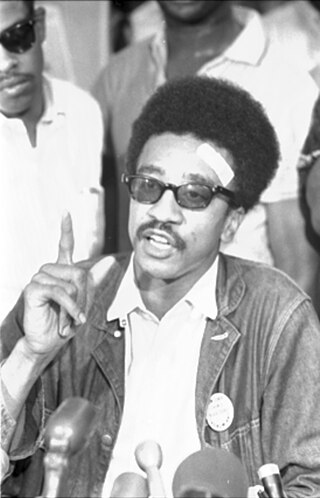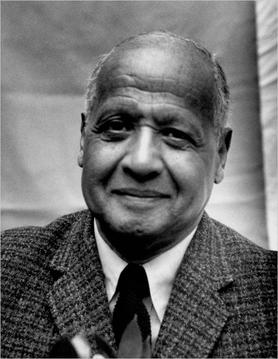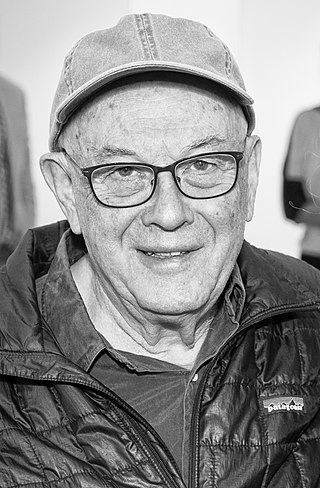
Jamil Abdullah al-Amin, is a human rights activist, Muslim cleric, black separatist, and convicted murderer who was the fifth chairman of the Student Nonviolent Coordinating Committee (SNCC) in the 1960s. Best known as H. Rap Brown, he served as the Black Panther Party's minister of justice during a short-lived alliance between SNCC and the Black Panther Party.

The Student Nonviolent Coordinating Committee was the principal channel of student commitment in the United States to the civil rights movement during the 1960s. Emerging in 1960 from the student-led sit-ins at segregated lunch counters in Greensboro, North Carolina, and Nashville, Tennessee, the Committee sought to coordinate and assist direct-action challenges to the civic segregation and political exclusion of African Americans. From 1962, with the support of the Voter Education Project, SNCC committed to the registration and mobilization of black voters in the Deep South. Affiliates such as the Mississippi Freedom Democratic Party and the Lowndes County Freedom Organization in Alabama also worked to increase the pressure on federal and state government to enforce constitutional protections.

Freedom Summer, also known as the Freedom Summer Project or the Mississippi Summer Project, was a volunteer campaign in the United States launched in June 1964 to attempt to register as many African-American voters as possible in Mississippi. Blacks had been restricted from voting since the turn of the century due to barriers to voter registration and other laws. The project also set up dozens of Freedom Schools, Freedom Houses, and community centers such as libraries, in small towns throughout Mississippi to aid the local Black population.

Garry Winogrand was an American street photographer, known for his portrayal of U.S. life and its social issues, in the mid-20th century. Photography curator, historian, and critic John Szarkowski called Winogrand the central photographer of his generation.
Lee Friedlander is an American photographer and artist. In the 1960s and 1970s, Friedlander evolved an influential and often imitated visual language of urban "social landscape," with many of his photographs including fragments of store-front reflections, structures framed by fences, posters and street signs. His work is characterized by its innovative use of framing and reflection, often using the natural environment or architectural elements to frame his subjects. Over the course of his career, Friedlander has been the recipient of numerous awards and his work has been exhibited in major museums and galleries worldwide.
Hugh Edwards (1903–1986) was an American curator of photography, based in Chicago, Illinois at the Art Institute of Chicago during the 1960s. Considered highly influential, Edwards was one of a handful of key curators, along with Alfred Stieglitz, Edward Steichen and John Szarkowski, who worked to gain the acceptance in the United States of fine art photography and documentary photography as art forms.

Roy Rudolph DeCarava was an American artist. DeCarava received early critical acclaim for his photography, initially engaging and imaging the lives of African Americans and jazz musicians in the communities where he lived and worked. Over a career that spanned nearly six decades, DeCarava came to be known as a founder in the field of black and white fine art photography, advocating for an approach to the medium based on the core value of an individual, subjective creative sensibility, which was separate and distinct from the "social documentary" style of many predecessors.

Robert Parris Moses was an American educator and civil rights activist known for his work as a leader of the Student Nonviolent Coordinating Committee (SNCC) on voter education and registration in Mississippi during the Civil Rights Movement, and his co-founding of the Mississippi Freedom Democratic Party. As part of his work with the Council of Federated Organizations (COFO), a coalition of the Mississippi branches of the four major civil rights organizations, he was the main organizer for the Freedom Summer Project.
Gilles Peress is a French photographer and a member of Magnum Photos.

Stephen Shore is an American photographer known for his images of scenes and objects of the banal, and for his pioneering use of color in art photography. His books include Uncommon Places (1982) and American Surfaces (1999), photographs that he took on cross-country road trips in the 1970s.

Doris Adelaide Derby was an American activist and documentary photographer. She was the adjunct associate professor of anthropology at Georgia State University and the founding director of their Office of African-American Student Services and Programs. She was active in the Mississippi civil rights movement, and her work discusses the themes of race and African-American identity. She was a working member of the Student Nonviolent Coordinating Committee (SNCC) and co-founder of the Free Southern Theater. Her photography has been exhibited internationally. Two of her photographs were published in Hands on the Freedom Plow: Personal Accounts by Women in SNCC, to which she also contributed an essay about her experiences in the Mississippi civil rights movement.

Bruce Landon Davidson is an American photographer. He has been a member of the Magnum Photos agency since 1958. His photographs, notably those taken in Harlem, New York City, have been widely exhibited and published. He is known for photographing communities usually hostile to outsiders.

Eugene Richards is an American documentary photographer living in Brooklyn, New York. He has published many books of photography and has been a member of Magnum Photos and of VII Photo Agency. He was born in Dorchester, Massachusetts.
Max Kozloff is an American art historian, art critic of modern art and photographer. He has been art editor at The Nation, and Executive Editor of Artforum. His essay "American Painting During the Cold War" is of particular importance to the criticism on American Abstract Expressionism.
Benedict Joseph Fernandez III was an American educator and journalistic and documentary street photographer. He is noted for photographing the protest movements of the 1960s, particularly those of the civil rights movement and the anti-Vietnam War movement.

Wayne Forest Miller was an American photographer known for his series of photographs The Way of Life of the Northern Negro. Active as a photographer from 1942 until 1975, he was a contributor to Magnum Photos beginning in 1958.

Clifford A. "Sonny" Vaughs was an American civil rights activist, filmmaker, and motorcycle builder. Vaughs designed the two chopper motorcycles used for the 1969 film Easy Rider, while an associate producer on the film. He also produced and directed the documentary What Will the Harvest Be? (1965) and Not So Easy (1972).

Kenneth Randall Light is an American social documentary photographer based in the San Francisco Bay Area. He is the author of twelve monographs, including Midnight La Frontera, What'sGoing On? 1969-1974,Delta Time, TexasDeath Row and, most recently, Course of the Empire, published by Steidl. He wrote Witness in our Time: Working Lives of Documentary Photographers, a collection of recollections and interviews with 29 of the world's most well-known photographers, editors and curators of the genre. He has had his photographs included as part of photo essays and portfolios in newspapers, magazines and other media, has been exhibited worldwide and is part of museum collections such as SF Museum of Modern Art and International Center of Photography. Light was also a co-founder of Fotovision, the Mother Jones International Fund for Documentary Photography and he is the recipient of a Guggenheim Fellowship and three National Endowment for the Arts photography fellowships. He is also a professor at the Graduate School of Journalism at UC Berkeley where he holds the Reva and David Logan chair in photojournalism and he is the director of the school's Logan documentary photography gallery.

The Bikeriders is a 2023 American drama film written and directed by Jeff Nichols. It tells a fictional story inspired by the 1967 photo-book of the same name by Danny Lyon depicting the lives of the Outlaws MC, a mainly Chicago based motorcycle club. The film features an ensemble cast that includes Jodie Comer, Austin Butler, Michael Shannon, Mike Faist, Norman Reedus, and Tom Hardy.














